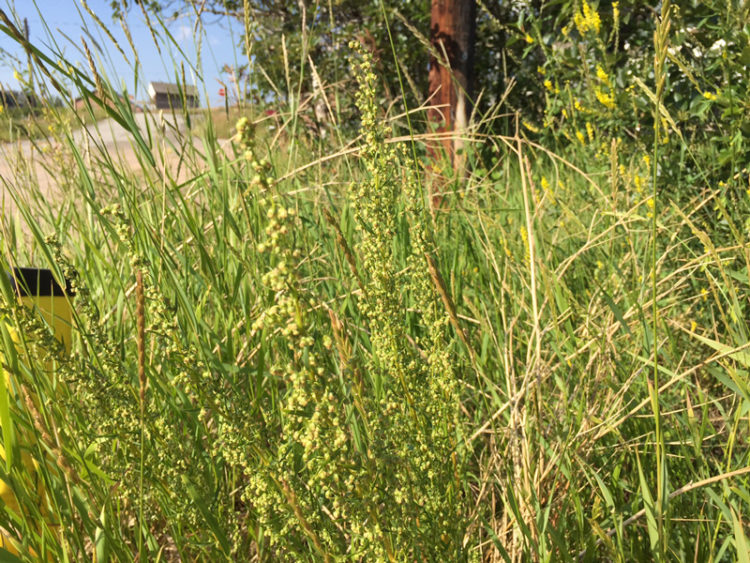
I am in love. Wild tarragon. It is the same species as the cultivated herb, but grows wild as a native species throughout much of the U.S. and Canada. I can’t believe I didn’t notice it sooner.
Wild tarragon is concentrated in the western United States—south to New Mexico and parts of Texas, west to the coast, and north into Canada—but it can be found as far east as Illinois and parts of New England. In Illinois it is considered endangered, and in Nebraska it is considered a weed.
It occurs from the plains to the mountains, and with a little searching I have found it in my town at 10,000 feet in Colorado’s high country, at 8,000 feet in Buena Vista on the Eastern Slope and Minturn on the Western Slope, and in the Denver-adjacent plains. In some places I have seen it growing sporadically in small colonies, but in others it is quite prolific. It is said to be very common in the Four Corners region.

Wild tarragon has long gone by the binomial Artemisia dracunculus, although our local taxonomists Weber and Wittmann use the name Oligosporus dracunculus subs. glauca (2012). The plant is frequent throughout Colorado. Despite the fact that it is a native species, it has a weedy nature, they write.
To find it, take a fresh look at the dry, open sites around you, or even that patch of tall weeds at the corner of your street. Look for it on open, dry, high country hillsides.

Tarragon stands out with its clusters of tall, sturdy stalks; those of the previous year are reddish in color. Once in flower, each stalk sports a dense cluster of many tiny, ball-shaped, yellowish flower heads. The leaves are green, alternate, unlobed or 1-2 times forked near the tip, linear, and pointed, with smooth (not serrated) edges.

Some of the other Artemisias look similar due to their flowerheads, but have pinnately divided leaves or are more gray-green in appearance.
Scent offers another clue, because good wild tarragon has a strong tarragon smell when you rub the leaves between your fingers, and the expected licorice-like flavor of tarragon. However, there is variation between populations and some wild tarragon is relatively scentless. I figure if it doesn’t smell like tarragon, you don’t want it for cooking anyway.

The first wild tarragon I found was in full flower. While there were still tarragon-scented leaves to aid in identification, they weren’t as lush or potent as they were on a fresh sprig that shot up later in my neighbor’s mowed lawn.

I started my culinary journey with wild tarragon by infusing some vinegar. So far it has gone into two preparations: a pork marinade with soy sauce and maple syrup; and a cocktail with elderflower liqueur and gooseberry juice.

I am just starting to dream of all the other wonderful things I can make with wild tarragon–salad dressings, béarnaise, French-style tomato sauce. If you have suggestions, please don’t hesitate to share. The fun with wild tarragon has only just begun.
Updated 2.25.21. (I categorized this post under summer and fall. Early to mid summer is the peak season, but flavorful new sprigs can be found in fall too, especially at higher elevations.)

Wow, I had no idea that was tarragon! I’ve definitely seen that before. Thanks!
ok, after the fact, but maybe the next time you harvest try adding wild tarragon to creamed tomatoes (they love each other!) and if you have any vinegar left, I like it very much sprinkled on a greens omelet
Actually this is great timing, thank you. I’ve had my eye on a patch of tarragon for a couple days now. I think today is harvest day:)
Just found this plant in my area. Your post on this is super helpful, as usual. Love your recipe ideas for it!
Thank you Mike!
https://www.allrecipes.com/recipe/22808/lettuce-and-tarragon-soup/
This soup is delicious!
Oh neat! I will have to try that, thank you.
Is this the stuff that grows knee-high all over my yard? It looks like tarragon but it has no taste and smell. Is it edible? I’m in Southwestern Colorado near the Royal Gorge
Erica,
Thank you for this informative article on Wild Tarragon. It has helped identify a “weed” that I’ve been trying to figure out.
May have to treat Wild Tarragon as one would mint as it can reproduce via its root structure. At least this is the case in loose sandy soil.
Sincerely,
Alan
Well I can’t be sure if that’s the same stuff without a picture or description, but wild tarragon sometimes has no scent, and sometimes it has a strong scent, so it might it.
You are most welcome! I hope your tarragon is one of the nice-smelling varieties.
To be on the safe side..if it doesnt smell like lemon, mint, aniseed or just a pungent spicy scent, dont consume. Amidst my tarragon a similar looking weed with white flowers grow but it is not scented, so I simply gid rid of it.
I’ve had it growing in my yard for years and didn’t know what it was until last year when I installed a plant identifier app. Woohoo